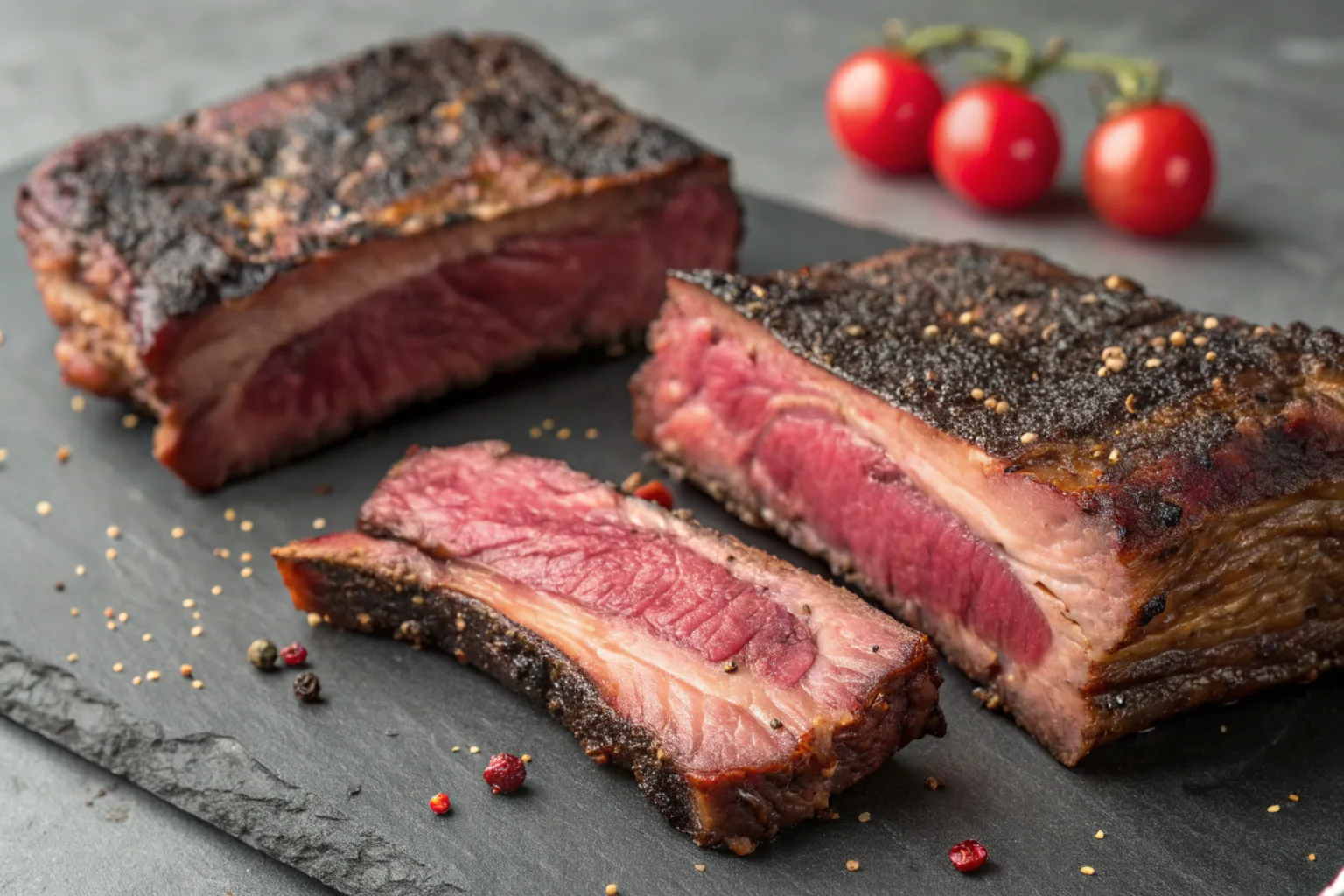Beef Back Ribs: The Ultimate Guide to Cooking Perfection
If you’re craving a mouthwatering, finger-licking meal, beef back ribs should be at the top of your list. This guide covers everything from choosing the best ribs to cooking them perfectly in your oven. We’ll explore essential tips, techniques, and common mistakes to avoid. By the end, you’ll be ready to create a savory masterpiece that melts in your mouth.
What Are Beef Back Ribs?
Beef back ribs are a delicious cut of beef taken from the top of the ribcage, where prime rib roasts are trimmed. Unlike short ribs, which are thicker and meatier, beef back ribs have less meat but pack an intense, beefy flavor.
These ribs are a hit at BBQs, family dinners, and holiday feasts. Their rich, juicy texture makes them ideal for slow-cooking methods like oven-baking or smoking.
Beef Back Ribs vs. Short Ribs
- Cut Location:
- Beef back ribs come from the upper rib section, near the spine.
- Short ribs are cut from the lower rib area, close to the belly.
- Meat Content:
- Back ribs have less meat but offer a tender, fall-off-the-bone experience.
- Short ribs are meatier but tougher, requiring longer cooking times.
- Cooking Methods:
- Back ribs are perfect for baking, grilling, or slow-cooking.
- Short ribs are often braised or slow-cooked for hours to soften their tough fibers.
Why Are Beef Back Ribs So Popular?
The answer is simple: their bold beefy flavor and juicy tenderness make them irresistible when cooked right. They’re great for special occasions or a hearty weekend meal when you’re in the mood for something truly satisfying.
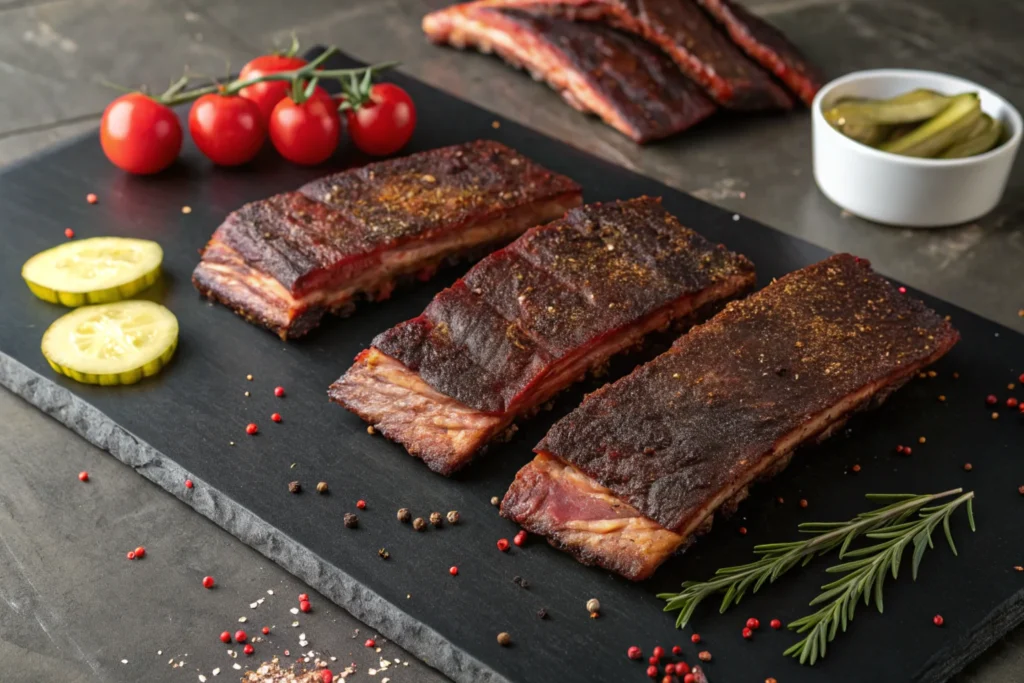
Beef Back Ribs Overview
Types of Beef Ribs
When it comes to beef back ribs, understanding different cuts helps you pick the right one for your recipe. While back ribs and short ribs both come from the cow’s rib section, they offer unique textures and flavors.
Back Ribs vs. Short Ribs
- Beef Back Ribs:
These come from the upper ribcage, offering long bones with a small amount of meat but exceptional flavor. They’re best when cooked low and slow, making them ideal for baking or smoking. - Short Ribs:
Short ribs are meatier but tougher. They’re cut from the lower chest and are perfect for braising or slow-cooking to break down their dense connective tissues.
Best Cuts for Cooking
Look for ribs with:
- Marbling: The more fat streaks, the juicier the meat.
- Even Bone Size: Consistent bones ensure even cooking.
For more details on beef rib cuts, check out Beef It’s What’s For Dinner.
Flavor and Texture
The beef back ribs’ appeal lies in their rich, meaty taste and tender, juicy texture. When cooked properly, the meat becomes soft, flavorful, and falls right off the bone. Here’s what makes them irresistible:
- Flavor Profile: A deep, beefy richness thanks to the rib’s location near prime rib cuts.
- Tenderness: Slow-cooking breaks down the meat’s tough fibers, turning them juicy and succulent.
Whether grilled or oven-baked, the caramelized crust from BBQ sauce enhances their taste, creating an irresistible combination of smoky and sweet flavors.
PChoosing and Preparing Beef Back Ribs
How to Choose the Best Ribs
When shopping for beef back ribs, selecting the right cut is essential for the best results. Here’s what to consider:
What to Look For:
- Fresh vs. Frozen: Fresh ribs yield the best texture, though properly thawed frozen ribs work too.
- Bone Size and Marbling: Choose ribs with thicker bones and plenty of visible fat marbling for maximum tenderness.
- Avoid Excess Fat: While some fat adds flavor, too much can result in greasy ribs.
Preparation Steps
The secret to perfect beef back ribs lies in how you prep them before cooking. Follow these easy steps:
Trimming the Ribs
- Remove the Silver Skin: This tough membrane on the bone side won’t break down during cooking. Use a sharp knife to peel it off.
- Trim Excess Fat: Leave a thin layer of fat for added flavor, but cut off any large chunks.
Marinating Options
- Dry Rub: A mix of salt, pepper, paprika, and garlic powder creates a bold, savory crust. Let it sit for at least an hour.
- Marinade: Use acidic ingredients like vinegar, lemon juice, or soy sauce to tenderize the meat. Marinate for at least 4 hours or overnight.
For expert seasoning tips, visit Serious Eats.
Cooking Beef Back Ribs in the Oven
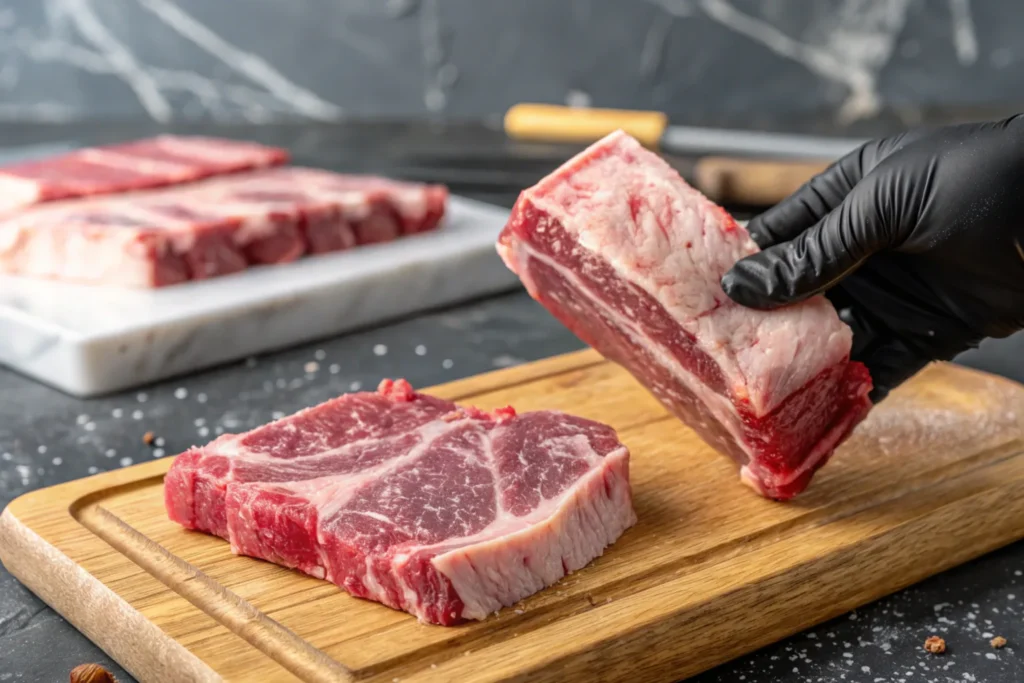
How to Cook Beef Back Ribs in the Oven
Cooking beef back ribs in the oven is an easy and rewarding process. With the right temperature and a bit of patience, you can create a flavorful and juicy dish that’s perfect for family dinners or weekend feasts.
Low-and-Slow Cooking: The Secret to Juicy Ribs
The key to tender beef back ribs is cooking them slowly at a low temperature. This method breaks down tough connective tissue while keeping the meat juicy and flavorful.
Why Low-and-Slow Works:
- It allows even cooking from the inside out.
- It melts the fat, making the ribs moist and tender.
Best Temperature and Time:
- Preheat the oven to 275°F (135°C).
- Bake for 3-4 hours, depending on rib size.
Step-by-Step Guide
- Preheat the Oven: Set to 275°F (135°C).
- Prepare a Baking Sheet: Line with foil for easier cleanup.
- Season the Ribs: Apply a dry rub or marinade generously.
- Wrap in Foil: This keeps the ribs moist during cooking.
- Bake for 3-4 Hours: Check doneness at the 3-hour mark.
- Unwrap for Browning: During the last 30 minutes, remove foil and baste with BBQ sauce for a caramelized finish.
Pro Tip:
For extra smoky flavor, try adding a few drops of liquid smoke to the marinade or using smoked paprika in your dry rub.
For more oven-baking tips, visit Eminent Recipes – Easy Southern Cooking Guide.
Advanced Cooking Tips for Beef Back Ribs
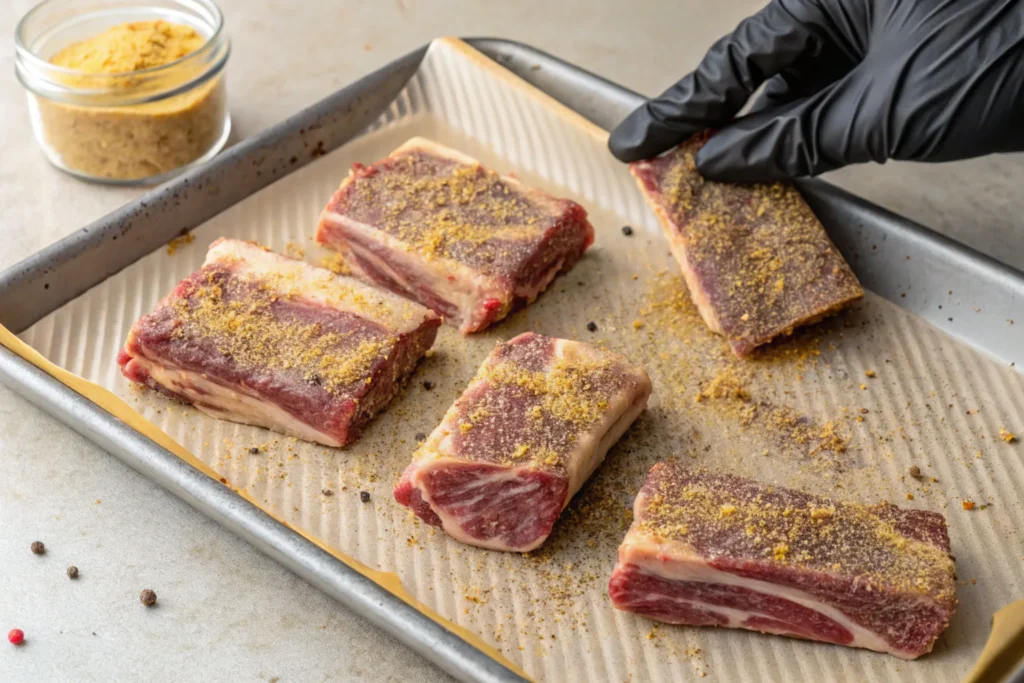
Techniques for Perfect Results
Even seasoned cooks can use a few extra tricks to elevate their beef back ribs game. These expert techniques ensure the perfect balance of tenderness and flavor.
Basting with Sauce:
- Apply BBQ sauce during the last 30 minutes of baking for a sticky, caramelized crust.
Creating a Crispy Exterior:
- For a crispy finish, broil the ribs for 3-5 minutes after baking. Watch carefully to prevent burning.
Common Mistakes to Avoid
Even with the best intentions, these common errors can turn a perfect rack of beef back ribs into a dry or bland meal:
- Overcooking:
Ribs cooked too long at a high temperature can become dry and tough. Stick to the recommended low-and-slow method. - Skipping the Foil Wrap:
Without foil, moisture escapes, making the ribs chewy. - Undersaucing:
Don’t skimp on the BBQ sauce. It adds depth, sweetness, and a beautiful glaze.
For more cooking tips and recipes, check out Eminent Recipes – Southern Classics.
FAQs:
When cooking beef back ribs, common questions often come up. In this section, we’ll answer the most frequently asked questions to help you master the art of making tender, juicy ribs.
1. What’s the Difference Between Beef Back Ribs and Short Ribs?
Beef back ribs come from the upper ribcage, near the spine, and have less meat but a deeper, beefier flavor. Short ribs are meatier, taken from the lower chest, and are ideal for braising or slow-cooking because they are tougher. If you want tender ribs with a bold taste, back ribs are the way to go.
2. How Long Should You Cook Beef Back Ribs in the Oven?
For perfectly cooked beef back ribs, bake them at 275°F (135°C) for 3 to 4 hours. This low-and-slow method ensures tender, juicy meat that falls off the bone. If you prefer a more caramelized exterior, broil the ribs for 3-5 minutes after baking.
3. Do You Have to Wrap Ribs in Foil?
Wrapping ribs in foil, also known as the “Texas Crutch,” keeps the meat moist and speeds up cooking. If you want ultra-tender ribs, wrapping is recommended. However, if you prefer a crispy, caramelized crust, leave them uncovered for the last 30 minutes of baking.
4. Can You Marinate Beef Back Ribs Overnight?
Yes, marinating overnight is an excellent way to enhance the flavor of beef back ribs. Use a marinade with acidic ingredients like vinegar, lemon juice, or soy sauce to tenderize the meat while adding a rich, savory taste. Refrigerate the ribs for at least 4 hours or, for the best results, leave them overnight.
5. How Do You Know When Beef Back Ribs Are Done?
The internal temperature should reach 200°F (93°C) for fully cooked ribs. You can also check for doneness by pulling on the bones—if they slide out easily, the ribs are ready. Another sign is when the meat is tender and has a deep brown, caramelized crust.
6. What’s the Best Way to Reheat Beef Back Ribs?
To keep the ribs juicy when reheating, wrap them in foil and bake at 250°F (120°C) for 20-30 minutes. For added flavor, brush with BBQ sauce before reheating. Avoid microwaving, as it can dry out the meat and make it rubbery.

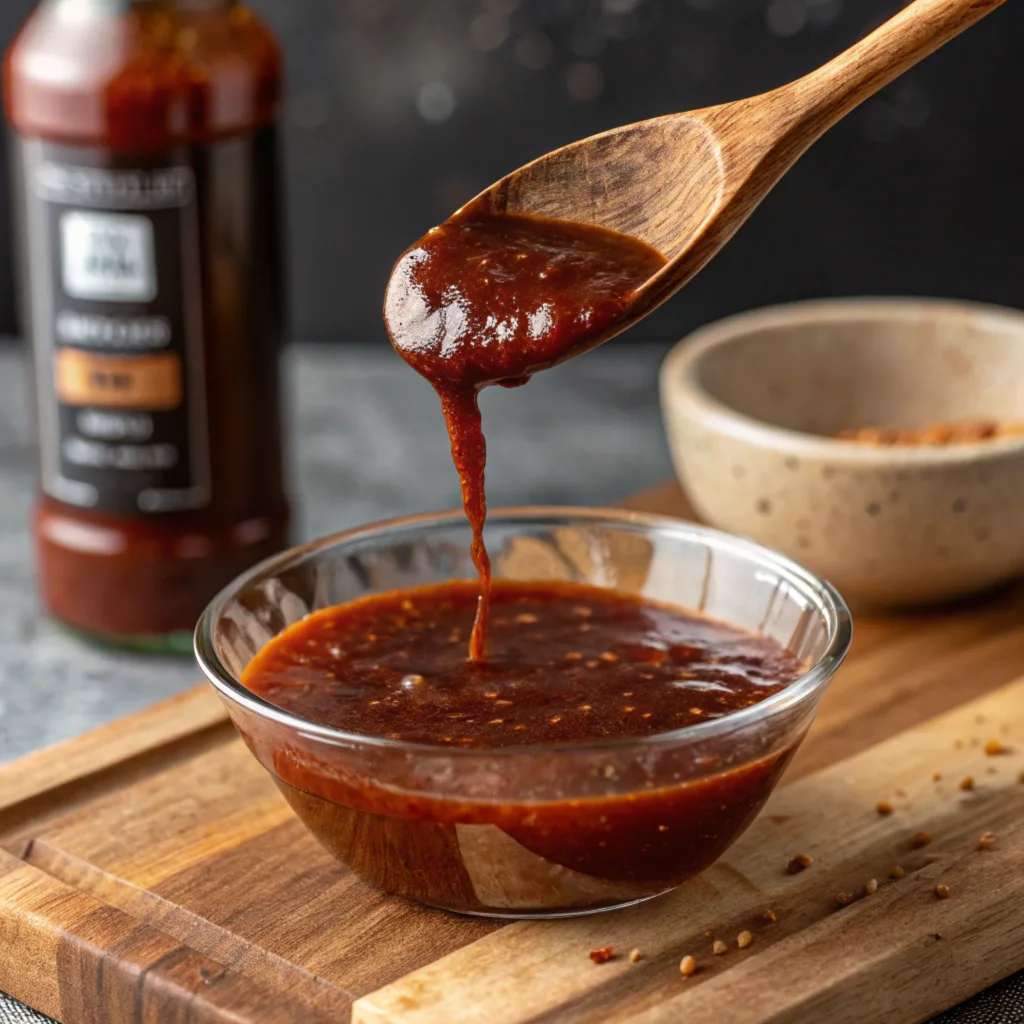
Conclusion
Cooking beef back ribs at home may seem challenging, but with the right approach, it’s much simpler than you might expect. Whether you’re a novice or an experienced cook, following tried-and-true methods ensures a delicious, satisfying meal that’s perfect for any occasion. By choosing the best cuts, using flavorful marinades, and cooking them low and slow, you’ll achieve tender, juicy ribs that practically fall off the bone every time.
Why Preparation Matters
Success in cooking beef back ribs starts long before you put them in the oven. Proper preparation, including removing the tough silver skin from the back of the ribs, is crucial for allowing flavors to penetrate the meat. Applying a well-balanced dry rub or a savory marinade enhances the taste while adding layers of mouthwatering depth.
When seasoning your ribs, don’t hesitate to experiment with spices like smoked paprika, garlic powder, or cumin for a smoky, bold flavor. Let the dry rub rest on the meat for at least an hour or, better yet, overnight for maximum impact. This step ensures your ribs are well-seasoned from the inside out.
Mastering the Cooking Process
The secret to perfect beef back ribs lies in slow-cooking them at a low temperature. This method gradually breaks down the tough connective tissue, leaving the meat juicy and tender. For optimal results, set your oven to 275°F (135°C) and bake the ribs for 3 to 4 hours. Remember, patience pays off when it comes to ribs!
Wrapping the ribs in foil, also known as the “Texas Crutch,” keeps the moisture locked in while they bake. The steam created inside the foil prevents the meat from drying out, ensuring every bite is juicy and flavorful. If you’re aiming for a smoky flavor but don’t have a grill, try adding a few drops of liquid smoke or using smoked paprika in your rub.
During the last 30 minutes of cooking, remove the foil and brush the ribs generously with your favorite BBQ sauce. This finishing step creates a caramelized crust that’s sticky, sweet, and utterly irresistible. If you want an even deeper char, broil the ribs for 3-5 minutes, keeping a close eye to avoid burning.
Avoiding Common Pitfalls
Even seasoned cooks can run into problems when making beef back ribs. The most frequent issues include overcooking, underseasoning, or skipping key steps like foil-wrapping. Here’s how to avoid these pitfalls:
- Don’t Overcook: While low-and-slow is the rule, cooking the ribs too long or at too high a temperature can make them dry and tough. Stick to the recommended oven settings for the best outcome.
- Season Thoroughly: Be generous with your seasoning or marinade. Since beef back ribs have less meat than short ribs, proper seasoning ensures every bite is flavorful.
- Wrap for Moisture: Skipping the foil wrap may save time but will result in drier ribs. Wrapping them ensures tenderness by trapping steam throughout the cooking process.
Personalizing Your Recipe
One of the best things about beef back ribs is how incredibly adaptable they are. In fact, you can easily tailor the recipe to match your unique taste preferences. For example, if you’re craving something sweet and tangy, simply use a honey-based BBQ sauce to add a touch of natural sweetness. On the other hand, if you prefer something spicy, consider adding cayenne pepper or hot sauce to your rub to intensify the heat and create a bold, flavorful kick. In this way, customizing your ribs becomes both fun and delicious!
You can also try international-inspired flavors. Think Korean-style ribs with a soy-ginger glaze, or Mexican-inspired ribs with a chipotle and lime marinade. The possibilities are endless, making ribs a versatile option for various cuisines and celebrations.
Serving Suggestions
Ribs are best enjoyed with classic side dishes like creamy coleslaw, baked beans, or cornbread. A crisp green salad or roasted vegetables can balance the richness of the meat. For a more indulgent meal, consider pairing the ribs with loaded mashed potatoes or mac and cheese.
If you’re hosting a backyard BBQ or a casual get-together, set up a build-your-own rib platter with different sauces and seasonings so guests can customize their servings. This interactive experience is fun and ensures everyone gets the flavors they love.

